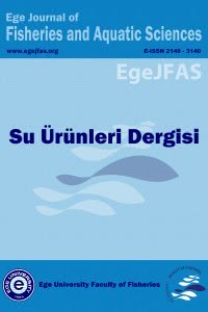Işık ve sıcaklık değişimlerinin Chaetoceros gracilis Schütt ( Bacillariophyceae ) üzerine etkileri
organik madde, sucul kültür, çevresel faktörler, sıcaklık, büyüme, fitoplankton, büyüme performansı, ışık ilişkisi, ışık
The effects of light and temperature variations on cahaetoceros gracilis Schütt (Bacillariohyceae)
organic matter, aquaculture, environmental factors, temperature, growth, phytoplankton, growth performance, light relations, light,
___
Allan, G.G., Lewin, J., Johnson, P.G., 1972. Mafine Polymers. IV. Diatom Polysaccharides. Bot.Mar. 15, 102-108.Brown, M.R., Miller, K.A., 1992. The ascorbic acid content of eleven species of microalgae used in mariculture. Journal of Applied Phycology. 4: 205-215.
Brown, M.R., Farmer, CL., 1994. Riboflavin content of six species of mikroalgae used in mariculture. Journal of Applied Phycology. 6: 61-65.
Darley, W.M., 1982. Algal Biology: A Physiological Approach. in Basic Microbiology (Ed. J.F. Wilkinson) Vol. 9. Blackwell Scientific Publications. 164 p.
Egemen, Ö., Sunlu, U., 1996. Su Kalitesi. Ege Üniversitesi Su Ürünleri Fak. Yayln No. 14 (Ders kitabl). 153 s.
Eppley, R.W., 1972. Temperature and Phytoplankton Growth in the Sea. Fishery Bulletin: 70 (4): 1063-1085.
Fiala, M. , Oriol, L. , 1990. Light-Temperature Interactions on the Growth of Antarctic Diatoms. Polar Biology, 10: 629-636.
Guillard, R.R.L., 1973. Division rates in Handbook of Phycological Methods-Culture Methods and Growth Measurements. (Ed.J.R. Stein). pp. 289-31 1.
Guillard, R.R.L., 1975. Culture of Phytoplankton For Feeding Marine Invertebrates. in: Smith, W.L. and M.H. Chanley (Eds.), Culture of Marine Invertebrate Animals. Plenum Press, New York, NY.
Hoshaw, R. V. , Rosowski, J.R., 1973. Methods For Microscopic Algae (53-65 p) in Handbook Stein) Cambridge University Press.
Ignatiades, L. , Fogg, G.E., 1973. Studies on the factors affecting the release of organic matter Skeletonema costatum (Greville) Cleve in Culture. J.Mar.Biol.Ass.U.K. 53, 937-956.
Lombardi, A.T., Wangersky, P.J., 1991. Influence of Phosphorus and Silicon on Lipid by Marine Diatom Chaetoceros gracilis Grown in Turbidostat Cage Cultures. Marine Ecology Progress Series. 77: 30-47.
Lombardi, A.T., Wangersky, P.J., 1995. Particulate Lipid Class Composition of Three Marine Phytoplankters Chaetoceros gracilis, Isochrysis galbana (Tahiti) and Dunaliella tertiolecta Grown in Batch Culture. Hydrobiologia, 306: 1-6.
Okay, O.S., Morkoç, E, Tüfekçi, V., 1994. Fitoplanktonlann (Jreme Kinetiklerinin Besin Elementlerinin, Atiksulann ve Zehirli Maddelerin Etkisi Altlnda Kesiki ve Sürekli Sistemlerde Încelenmesi. Çevre Mühendisliýi Bölümü, TÜBÍTAK-MAM, Kasim, 1994, Gebze, Kocaeli.
Reitan, K.I., Rainuzzo, J.R., Olsen, Y. , 1994. Effect of Nutrient Limitation on Fatty Acid and Lipid Content of Marine Microalgae. J. Phycol. 30, 972-979.
Sanchez Saavedra, M.P., Voltolina, D, 1994a. The Chemical Composition of Chaetoceros (Bacillariophceae) Under Different Light Conditions. Comp.Biochem.Physiol. Vol. 107B, No. 1, pp. 39-44.
Sanchez Saavedra, M.P., Voltolina, D. , 1994b. The Effect of Different Photon Fluence Rates Blue-Green Light on the Biomass Quality of a Coastal Diatom in Pilot Scale, Semicontinuous Cultures. Il. Algal Photobiology Workshop, Universitad de Malaga Departmento de Ecologia, Facultad De Ciencias, Malaga, Spain.
Sanchez Saavedra, M.P., Voltolina, D. , 1995. The Effect of Different Light Quality on the Food Value of the Diatom Chaetoceros sp. for Artemia franciscana Kellogg Rivista Italiana Acquacoltura. 30: 135-138.
Thomas, W.H., 1966. Effects of Temperature and Illuminance on Cell Division Rates of Three Species Tropical Oceanic Phytoplankton. Journal of Phycology, 2 (I): 17-22.
Thomas, W.H., Dodson, A.N., 1972. On Nitrogen Deficiency in Tropical Pasific Oceanic Phytoplankton. Il. Photosynthetic and Cellular Characteristics of a Chemostat-Grown Diatom. Limnology & Oceanography. 17 (4): 515-523.
Werner, D. , 1977. Introduction With a Note on Taxonomy. In the Biology of Diatoms. (Ed.D.Werner) University of California Press. 498 p.
- ISSN: 1300-1590
- Yayın Aralığı: 4
- Başlangıç: 1984
- Yayıncı: Aynur Lök
Biotechnological tools in aquaculture and fisheries
Karadeniz'in fitoplankton kommunite yapılarında görülen bazı düzensiz değişimler
Türkiyenin Ege Denizi kıyılarının Caecidae ( Gastropoda- Molusca ) türleri
İstanbul balık hali ( Türkiye ) ve halde pazarlanan su ürünleri
Işık ve sıcaklık değişimlerinin Chaetoceros gracilis Schütt ( Bacillariophyceae ) üzerine etkileri
F.Sanem İZGÖREN, Baha BÜYÜKIŞIK
SEVİM KÖSE, Mustafa ZENGİN, İlker Zeki KURTOĞLU, Muhammet BORAN
H.Tuncay KINACIGİL, Ejder ÇIRA, T. Akın İLKYAZ
Mustafa ALPASLAN, Tufan KORAY, Fatma ÇOLAK
Önder YILDIRIM, M.Salih ÇELİKKALE, Y. Ali KORKUT, Belgin HOŞSU
